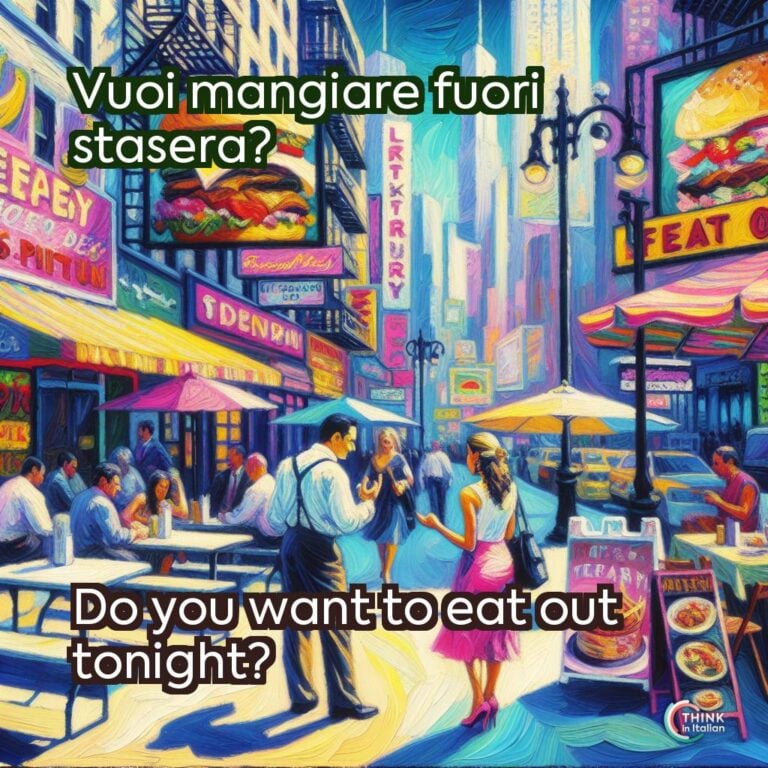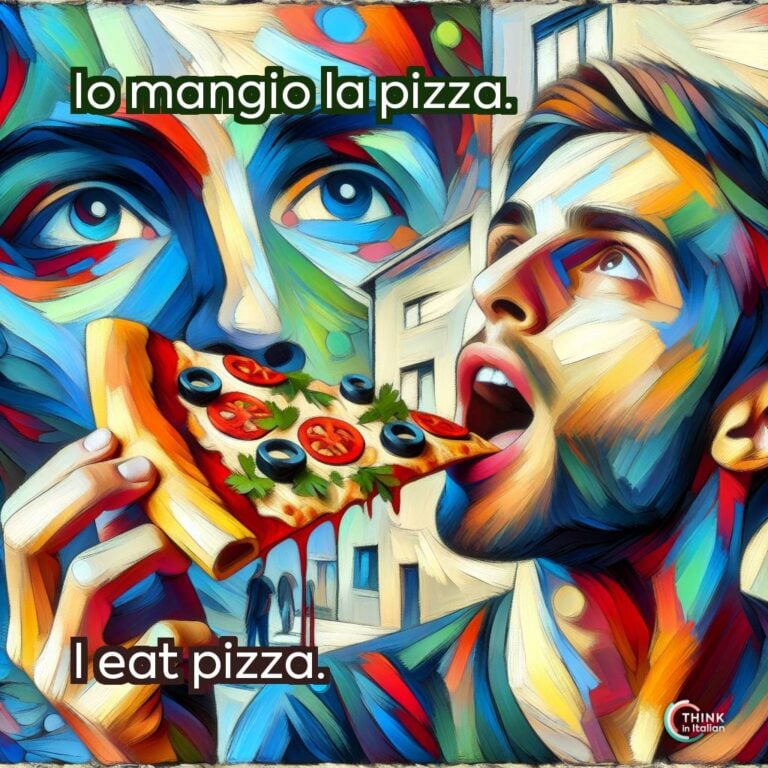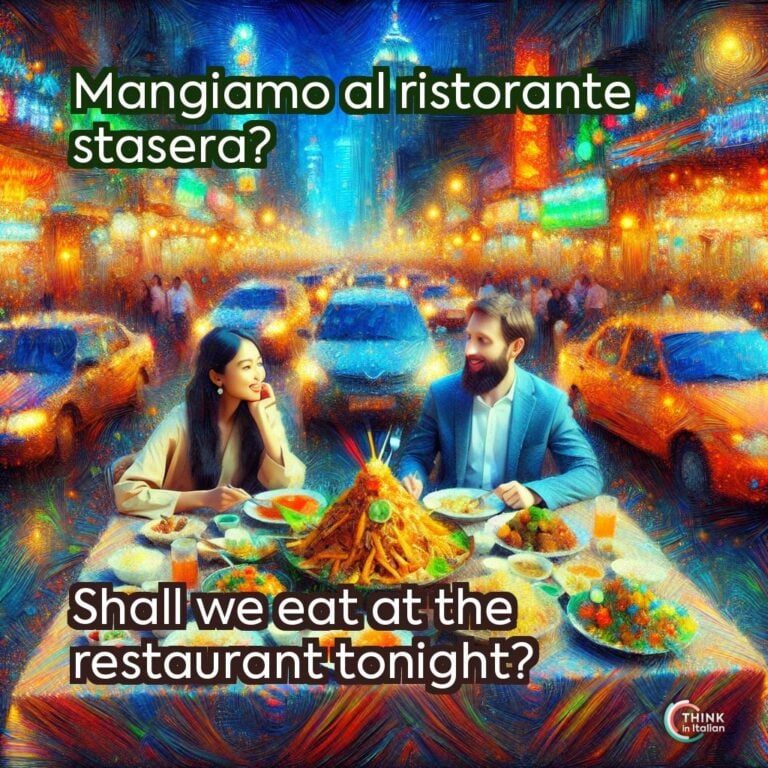The Verb “Mangiare” in Italian
Mangiare: Conjugation
Mangiare is a regular verb belonging to the first verb conjugation -are, making it straightforward to conjugate in most tenses. Here I will show you how it is conjugated in the main verb tenses of the indicative mood:
| Conjugation | English Translation |
|---|---|
| Io mangio | I eat |
| Tu mangi | You eat |
| Lui/Lei mangia | He/She eats |
| Noi mangiamo | We eat |
| Voi mangiate | You eat |
| Loro mangiano | They eat |
| Conjugation | English Translation |
|---|---|
| Io mangiavo | I was eating / I used to eat |
| Tu mangiavi | You were eating / You used to eat |
| Lui/Lei mangiava | He/She was eating / used to eat |
| Noi mangiavamo | We were eating / used to eat |
| Voi mangiavate | You were eating / used to eat |
| Loro mangiavano | They were eating / used to eat |
| Conjugation | English Translation |
|---|---|
| Io ho mangiato | I ate / I have eaten |
| Tu hai mangiato | You ate / You have eaten |
| Lui/Lei ha mangiato | He/She ate / has eaten |
| Noi abbiamo mangiato | We ate / We have eaten |
| Voi avete mangiato | You ate / have eaten |
| Loro hanno mangiato | They ate / have eaten |
| Conjugation | English Translation |
|---|---|
| Io mangerò | I will eat |
| Tu mangerai | You will eat |
| Lui/Lei mangerà | He/She will eat |
| Noi mangeremo | We will eat |
| Voi mangerete | You will eat |
| Loro mangeranno | They will eat |
Io mangio la pizza ogni venerdì.
I eat pizza every Friday.
Ho mangiato un gelato.
I ate an ice cream.
Domani mangerò la pasta.
Tomorrow I will eat pasta.
Mangiare: Italian Culture
The Italian “to eat” holds a special place in Italian language and culture. It’s not just about consuming food, but it represents a way of life, deeply connected to family, tradition, and social bonds.
Italian meals are carefully structured, each with its own cultural nuances:
- Colazione (breakfast): we typically eat sweet food, like cornetto (Italian croissant), fette biscottate (rusks), or biscotti (biscuits). Breakfast is incomplete without a coffee, typically an espresso or cappuccino.
- Spuntino (morning Snack): a light snack to bridge breakfast and lunch. My favorite spuntino is often a slice of pizza al taglio (pizza by the slice) or fruit.
- Pranzo (lunch): traditionally, pranzo is the main meal of the day, composed of antipasto (starter), primo (main course), secondo (second course), and dolce (dessert). While long lunches are less common in work environments, the Sunday lunch remains a sacred family ritual.
- Merenda (afternoon snack): for children and adults alike, merenda is a cherished pause. What you can have may vary a lot, but I personally love pane e Nutella (bread with Nutella).
- Aperitivo: it often replaces merenda. It is a beloved social ritual, where you drink and eat with friends. You can typically have Aperol Spritz with olive (olives), bruschette, and patatine (crisps).
- Cena (dinner): typically lighter than lunch, it might include soup or a simple secondo like grilled fish or a frittata (Italian omelette).
How to use “Mangiare” in Italian
“Fare” vs “Mangiare”
When talking about some meals, Italians often use the verb fare (to do/make) instead of mangiare. For example:
- Fare colazione (to have breakfast)
- Fare merenda (to have a snack)
In some dialects you might also hear fare pranzo (to have lunch) and fare cena (to have dinner), although we have specific verb to indicate these meals:
- Pranzare (to have lunch)
- Cenare (to have dinner)
What all these expressions have in common is that if you use the definite article, you’re saying you are preparing that meal. If you do not use the definite article, you’re saying you’re eating that meal.
Faccio la colazione e vado a lavoro.
I make breakfast and I go to work.
Faccio colazione e vado a lavoro.
I have breakfast and I go to work.
Sabato faccio pranzo con i miei parenti.
On Saturday I have lunch with my relatives.
Sabato faccio il pranzo con i miei parenti.
On Saturday I’ll make lunch with my relatives.
Mangiare: Idiomatic Expressions
There are many Italian idioms which feature the verb mangiare. Here I will show you the most common ones:
- Mangiarsi le parole (to eat one’s words): to mumble or speak unclearly.
Parla piano e si mangia le parole.
He speaks softly and mumbles his words.
- Rimangiarsi le parole (to re-eat one’s words): to go back on a promise.
Non puoi rimangiarti la parola!
You can’t go back on your word!
- Mangiare con gli occhi (to eat with your eyes): to intensely desire something.
Stava mangiando quella torta con gli occhi.
He was eating that cake with his eyes.
- Mangiarsi le mani (to eat one’s hands): to deeply regret something.
Mi mangio le mani per non aver detto di sì.
I’m kicking myself for not saying yes.
The joy of “Mangiare” in Italy
Mangiare is more than a verb, it’s a gateway to understanding Italy’s rich culinary traditions and vibrant culture. Embracing the Italian way of eating allows you to connect deeply with the culture and its people.
Start mastering conjugations, explore idioms and food vocabulary, and experience the structured rhythm of Italian meals to learn more about mangiare and appreciate what makes Italian life so unique.
So go ahead, immerse yourself, and always remember:
Mangiare bene è un’arte in Italia.
Eating well is an art in Italy.






